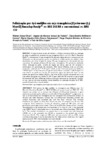Por favor, use este identificador para citar o enlazar este ítem:
http://www.alice.cnptia.embrapa.br/alice/handle/doc/1047804Registro completo de metadatos
| Campo DC | Valor | Lengua/Idioma |
|---|---|---|
| dc.contributor.author | CHIARI, W. C. | pt_BR |
| dc.contributor.author | TOLEDO, V. de A. A. de | pt_BR |
| dc.contributor.author | HOFFMANN-CAMPO, C. B. | pt_BR |
| dc.contributor.author | RÚVOLO-TAKASUSUKI, M. C. C. | pt_BR |
| dc.contributor.author | TOLEDO, T. C. S. de O. A. de | pt_BR |
| dc.contributor.author | LOPES, T. da S. | pt_BR |
| dc.date.accessioned | 2016-06-23T11:11:11Z | pt_BR |
| dc.date.available | 2016-06-23T11:11:11Z | pt_BR |
| dc.date.created | 2016-06-23 | pt_BR |
| dc.date.issued | 2008 | pt_BR |
| dc.identifier.citation | Acta Scientiarum. Agronomy, Maringá, v. 30, n. 2, p. 267-271, 2008. | pt_BR |
| dc.identifier.issn | 1679-9275 | pt_BR |
| dc.identifier.uri | http://www.alice.cnptia.embrapa.br/alice/handle/doc/1047804 | pt_BR |
| dc.description | RESUMO: O objetivo deste estudo foi verificar a influência de Apis mellifera na produção de grãos e qualidade de sementes da soja transgênica Glycine max (L.) Merrill Roundup ReadyTM e convencional. A soja transgênica foi plantada intercalada com a convencional, em 18 parcelas, em três tratamentos: gaiolas com abelhas A. mellifera, gaiolas sem abelhas e áreas descobertas, com livre visitação de insetos. Na soja transgênica, em três parcelas de cada tratamento, foi aplicado glifosato, 30 dias após a emergência. Os parâmetros analisados foram: produção de grãos; número de vagens por planta; peso de 100 sementes e porcentagem de germinação das sementes. Não houve diferença entre as cultivares, entretanto a produção de 2.757,40 kg ha-1 obtida na área coberta por gaiola com abelhas, e 2.828,47 kg ha-1 na área livre para visitação de insetos foram superiores a 2.000,53 kg ha-1 da área coberta por gaiola sem abelhas. O número de vagens por planta foi maior na área coberta por gaiola com abelhas (38,28) e área livre (32,65), quando comparado com o da área coberta por gaiola sem abelhas (21,19). O peso médio de 100 sementes e a germinação das sementes não foram diferentes entre as cultivares e nem entre os tratamentos. Conclui-se que, para as cultivares estudadas, houve benefício na produção de grãos de 37,84%, quando foi permitida a visita de abelhas. ABSTRACT. Pollination by Apis mellifera in transgenic soy (Glycine max (L.) Merrill) Roundup Ready? cv. BRS 245 RR and conventional cv. BRS 133. This research was carried out to evaluate the influence of Africanized honeybees in grain production and seed quality of Glycine max (L.) Merrill Roundup Ready? transgenic soy, as well as of conventional soy. Transgenic soy was interposed with conventional soybean, in 18 plots and three treatments: covered area with Africanized honeybees, covered area without honeybees, and uncovered area with free insect visitation. The herbicide Glyphosate was applied on three plots of each treatment of transgenic soy, 30 days after emergence. Grain production, number of pods/plant, weight per 100 seeds, and seed germination percentage were evaluated. There was no difference among cultivars; however, the production in the covered area with honeybees (2757.4 kg ha-1) and in the uncovered area (2828.47 kg ha-1) were higher than in the covered area without honeybees (2000.53 kg ha-1). The number of pods/plant was greater than in the covered area with honeybees (38.28) and in the uncovered area (32.65) as compared to the covered area without honeybees (21.19). The weight per 100 seeds seed germination did not differ among cultivars or treatments. It can be concluded that, for these cultivars, there was a rise in grain production of 37.84% when honeybee visits were allowed. | pt_BR |
| dc.language.iso | por | pt_BR |
| dc.rights | openAccess | pt_BR |
| dc.subject | Soja transgênica | pt_BR |
| dc.title | Polinização por Apis mellifera em soja em soja transgênica [Glycine max (L.) Merrill] Merrill] Roundup ReadyTM cv. BRS 245 RR e convencional cv. BRS 133. | pt_BR |
| dc.type | Artigo de periódico | pt_BR |
| dc.date.updated | 2017-08-31T11:11:11Z | pt_BR |
| riaa.ainfo.id | 1047804 | pt_BR |
| riaa.ainfo.lastupdate | 2017-08-31 -03:00:00 | pt_BR |
| dc.contributor.institution | WAINER CÉSAR CHIARI, UEM; VAGNER DE ALENCAR ARNAUT DE TOLEDO, UEM; CLARA BEATRIZ HOFFMANN CAMPO, CNPSO; MARIA CLAUDIA COLLA RÚVOLO-TAKASUSUKI, UEM; TIAGO CLEYTON SIMÕES DE OLIVEIRA ARNAUT DE TOLEDO, UEM TIAGO CLEYTON SIMÕES DE OLIVEIRA ARNAUT DE TOLEDO; TAIS DA SILVA LOPES, UEM. | pt_BR |
| Aparece en las colecciones: | Artigo em periódico indexado (CNPSO)  | |
Ficheros en este ítem:
| Fichero | Descripción | Tamaño | Formato | |
|---|---|---|---|---|
| PolinizacaoporApismellifera...2008.pdf | 120.57 kB | Adobe PDF |  Visualizar/Abrir |









